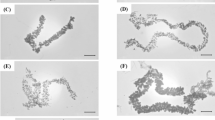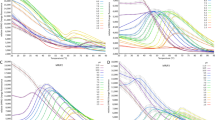Abstract
Honey bee (Apis spp.) royal jelly, a glandular secretion used to raise young larvae to future queens, has long been considered merely as food. Since queen larvae are raised upside down in their vertically oriented queen cells, royal jelly also needs to adhere the larvae to the cell ceiling to prevent the prospective queen from dropping out. This is exactly where the native acidic pH of royal jelly comes into play: only at a pH of 4.0 is royal jelly viscous enough to hold the larvae in their cells. We here show with the help of electron microscopy that royal jelly possesses a complex tissue-like organization at pH 4.0 which is similar to the dense extracellular matrix of animals providing structural support. The main structural elements at pH 4.0 are proteinaceous fibril bundles, embedded in a fibrillary net, that seem to be bunched in electron-dense structures, potential sites of fibril overlap and cross-linking. At an exogenously induced increased royal jelly pH of 7.0, these fibrillary structures are largely destroyed. This is when royal jelly viscosity decreases and holding the queen larvae in place is no longer guaranteed.




Similar content being viewed by others
References
Abràmoff MD, Magalhães PJ, Ram SJ (2004) Image processing with ImageJ. Biophoton Int 11:36–42
Aristotle (1965, original work published ca. 350 BC) Book 5, Part 21. In: Henderson J (ed) Peck AL (transl) historia animalium. Harvard University Press, Cambridge, p 189
Bowes JH, Cater CW (1965) The reaction of glutaraldehyde with proteins and other biological materials. J R Microsc Soc 85:193–200. https://doi.org/10.1111/j.1365-2818.1966.tb02180.x
Buttstedt A, Ihling CH, Pietzsch M, Moritz RFA (2016) Royalactin is not a royal making of a queen. Nature 537:E10–E12. https://doi.org/10.1038/nature19349
Buttstedt A, Mureşan CI, Lilie H, Hause G, Ihling CH, Schulze S-H, Pietzsch M, Moritz RFA (2018) How honeybees defy gravity with royal jelly to raise queens. Curr Biol 28:1095–1100. https://doi.org/10.1016/j.cub.2018.02.022
Callow RK, Johnston NC, Simpson J (1959) 10-Hydroxy-∆2-decenoic acid in the honeybee (Apis mellifera). Experientia 15:421–422. https://doi.org/10.1007/BF02157689
Deerinck TJ, Bushong EA, Thor A, Ellisman MH (2010) SBEM Protocol v7_01_10. NCMIR methods for 3D EM: a new protocol for preparation of biological specimens for serial blockface scanning electron microscopy. National Center for Microscopy and Imaging Research. https://ncmir.ucsd.edu/sbem-protocol. Accessed 12 Jun 2018
Deseyn J, Billen J (2005) Age-dependent morphology and ultrastructure of the hypopharyngeal gland of Apis mellifera workers (Hymenoptera, Apidae). Apidologie 36:49–57. https://doi.org/10.1051/apido:2004068
Dönhoff (1859) Beiträge zur Bienenkunde. IV. Welches Mittel wendet die Natur an, dass die Larve nicht vom Boden der Zelle herunterfällt? Eichstädter Bienenztg 15:33–34
Goldberg B, Sherr CJ (1973) Secretion and extracellular processing of procollagen by cultured human fibroblasts. Proc Natl Acad Sci USA 70:361–365. https://doi.org/10.1073/pnas.70.2.361
Hanes J, Šimúth J (1992) Identification and partial characterization of the major royal jelly protein of the honey bee (Apis mellifera L.). J Apic Res 31:22–26. https://doi.org/10.1080/00218839.1992.11101256
Hanker JS, Deb C, Wasserkrug HL, Seligman AM (1966) Staining tissue for light and electron microscopy by bridging metals with multidentate ligands. Science 152:1631–1634. https://doi.org/10.1126/science.152.3729.1631
Hayat MA (1981) Fixation for electron microscopy. Academic Press, New York
Herrera AM, McParland BE, Bienkowska A, Tait R, Paré PD, Seow CY (2005) ‘Sarcomers’ of smooth muscle: functional characteristics and ultrastructural evidence. J Cell Sci 118:2381–2392. https://doi.org/10.1242/jcs.02368
Hoffmann I (1960) Untersuchungen über die Herkunft von Komponenten des Königinnenfuttersaftes der Honigbienen. Z Bienenforschung 5:101–111
Huber F (1792) Lettre cinquieme. In: Nouvelles observations sur les abeilles. Barde, Manget & Compagnie, Imprimeurs-Libraires, Genève, p 164
Isidorov VA, Bakier S, Grzech I (2012) Gas chromatographic–mass spectrometric investigation of volatile and extractable compounds of crude royal jelly. J Chromatogr B 885–886:109–116. https://doi.org/10.1016/j.jchromb.2011.12.025
Kemmenoe BH, Bullock GR (1983) Structure analysis of sputter-coated and ion-beam sputter-coated films: a comparative study. J Microsc 132:153–163. https://doi.org/10.1111/j.1365-2818.1983.tb04267.x
Kheyri H, Cribb BW, Reinhard J, Claudianos C, Merritt DJ (2012) Novel actin rings within the secretory cells of honeybee royal jelly glands. Cytoskeleton 69:1032–1039. https://doi.org/10.1002/cm.21059
Kratky E (1931) Morphologie und Physiologie der Drüsen in Kopf und Thorax der Honigbiene (Apis mellifica L.). Z Wiss Zool 139:119–200
Kumar S, Udgaonkar JB (2010) Mechanisms of amyloid fibril formation by proteins. Curr Sci 98:639–656
Liu TP (1990) Ultrastructural analysis on the gland secretion in the extracellular ducts of the hypopharyngeal glands of the honeybee infected by Nosema apis. Tissue Cell 22:533–540. https://doi.org/10.1016/0040-8166(90)90081-J
Maleszka R (2018) Beyond Royalactin and a master inducer explanation of phenotypic plasticity in honey bees. Commun Biol 1:8. https://doi.org/10.1038/s42003-017-0004-4
Mandacaru SC, do Vale LH, Vahidi S, Xiao Y, Skinner OS, Ricart CA, Kelleher NL, de Sousa MV, Konermann L (2017) Characterizing the structure and oligomerization of major Royal Jelly Protein 1 (MRJP1) by mass spectrometry and complementary biophysical tools. Biochemistry 56:1645–1655. https://doi.org/10.1021/acs.biochem.7b00020
Patel NG, Haydak MH, Gochnauer TA (1960) Electrophoretic components of the proteins in honeybee larval food. Nature 186:633–634. https://doi.org/10.1038/186633a0
Pavel CI, Mărghitaș LA, Dezmirean DS, Tomoș LI, Bonta V, Şapcaliu A, Buttstedt A (2014) Comparison between local and commercial royal jelly—use of antioxidant activity and 10-hydroxy-2-decenoic acid as quality parameter. J Apic Res 53:116–123. https://doi.org/10.3896/IBRA.1.53.1.12
Pirk CWW (2018)) Honeybee evolution: royal jelly proteins help queen larvae to stay on top. Curr Biol 28:R350–R351. https://doi.org/10.1016/j.cub.2018.02.065
Porter KR, Kallman F (1953) The properties and effects of osmium tetroxide as a tissue fixative with special reference to its use for electron microscopy. Exp Cell Res 4:127–141. https://doi.org/10.1016/0014-4827(53)90195-5
Raspanti M, Viola M, Sonaggere M, Tira ME, Tenni R (2007) Collagen fibril structure is affected by collagen concentration and decorin. Biomacromolecules 8:2087–2091. https://doi.org/10.1021/bm070091t
Rembold H, Hanser G (1964) Über den Weiselzellenfuttersaft der Honigbiene VIII. Nachweis des determinierenden Prinzips im Futtersaft der Königinnenlarven. Hoppe-Seyler’s Z Physiol Chem 339:251–254. https://doi.org/10.1515/bchm2.1964.339.1.251
Sabatini DD, Bensch K, Barrnett RJ (1963) Cytochemistry and electron microscopy—preservation of cellular ultrastructure and enzymatic activity by aldehyde fixation. J Cell Biol 17:19–58. https://doi.org/10.1083/jcb.17.1.19
Schiemenz P (1883) Über das Herkommen des Futtersaftes und die Speicheldrüsen der Biene nebst einem Anhange über das Riechorgan. Z Wiss Zool 38:71–135
Schmitzová J, Klaudiny J, Albert S, Schröder W, Schreckengost W, Hanes J, Júdová J, Šimúth J (1998) A family of major royal jelly proteins of the honeybee Apis mellifera L.. Cell Mol Life Sci 54:1020–1030. https://doi.org/10.1007/s000180050229
Shuel RW, Dixon SE (1986) An artificial diet for laboratory rearing of honeybees. J Apic Res 25:35–43. https://doi.org/10.1080/00218839.1986.11100689
Snodgrass RE (1925) The alimentary canal and its glands. In: Anatomy and physiology of the honeybee. McGraw-Hill Book Company, New York, p 171
Swammerdam J (1738) Tractatus de Apibus. In: Boerhaave H (ed) Biblia Naturae sive Historia Insectorum. Isaak Severinus, Boudewyn van der Aa & Pieter van der Aa, Leiden, p 400
Theocharis AD, Skandalis SS, Gialeli C, Karamanos NK (2016) Extracellular matrix structure. Adv Drug Deliv Rev 97:4–27. https://doi.org/10.1016/j.addr.2015.11.001
Tian W, Li M, Guo H, Peng W, Xue X, Hu Y, Liu Y, Zhao Y, Fang X, Wang K, Li X, Tong Y, Conlon MA, Wu W, Ren F, Chen Z (2018) Architecture of the native major royal jelly protein 1 oligomer. Nat Commun 9:3373. https://doi.org/10.1038/s41467-018-05619-1
Vallet A, Cassier P, Lensky Y (1991) Ontogeny of the fine structure of the mandibular glands of the honeybee (Apis mellifera L.) workers and the pheromonal activity of 2-heptanone. J Insect Physiol 37:789–804. https://doi.org/10.1016/0022-1910(91)90076-C
Venable JH, Coggeshall R (1965) A simplified lead citrate stain for use in electron microscopy. J Cell Biol 25:407–408. https://doi.org/10.1083/jcb.25.2.407
von Planta A (1888) Über den Futtersaft der Bienen. Z Physiol Chem 12:327–354. https://doi.org/10.1515/bchm1.1888.12.4.327
Yamaguchi KY, He S, Li Z, Murata K, Hitomi N, Mozumi M, Ariga R, Enomoto T (2013) Quantification of Major Royal Jelly Protein 1 in fresh royal jelly by indirect enzyme-linked immunosorbent assay. Biosci Biotechnol Biochem 77:1310–1312. https://doi.org/10.1271/bbb.130013
Acknowledgements
This project was supported by the institutional strategy ‘The Synergetic University’ of the Technische Universität Dresden financed by the Excellence Initiative of the German federal and state governments. The Electron Microscopy Facility of the Center for Molecular and Cellular Bioengineering is supported by the European Regional Development Fund (EFRE, Grant number 100232736). We are very grateful to Michael Schlierf for providing infrastructural support for A.B. and we thank Alice Séguret for language editing.
Author information
Authors and Affiliations
Corresponding author
Ethics declarations
Conflict of interest
The authors have declared no conflict of interest.
Electronic supplementary material
Below is the link to the electronic supplementary material.
Rights and permissions
About this article
Cite this article
Kurth, T., Kretschmar, S. & Buttstedt, A. Royal jelly in focus. Insect. Soc. 66, 81–89 (2019). https://doi.org/10.1007/s00040-018-0662-3
Received:
Revised:
Accepted:
Published:
Issue Date:
DOI: https://doi.org/10.1007/s00040-018-0662-3




